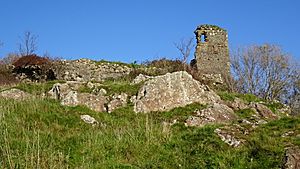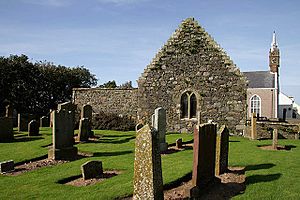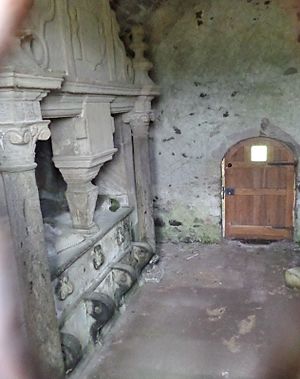Jean Stewart, Lady Bargany facts for kids
Jean Stewart, Lady Bargany (born around 1577 – died 1605) was an important Scottish lady. She worked for Anne of Denmark, who was the Queen of Scotland and later England. Jean's mother was also a senior lady-in-waiting to the Queen. Jean Stewart's marriage was quite interesting and is still studied by historians today.
Contents
Jean Stewart's Marriage Story
Jean Stewart married Gilbert Kennedy of Bargany and Ardstinchar. He was the third son of Thomas Kennedy of Bargany. Their family home, Bargany Castle, was located in Ayrshire, Scotland. It was later taken down in the 1600s.
Some old stories say that James VI of Scotland, the King, arranged this marriage for Gilbert Kennedy. The stories suggest the King did this to punish Gilbert's father, Thomas Kennedy. Thomas had been involved in a protest in Edinburgh in 1596. Because of this, the King supposedly arranged for Gilbert to marry Jean, who did not have a large dowry (money or gifts brought by the bride to the marriage).
The Edinburgh Protest of 1596
The protest happened in Edinburgh in November 1596. Thomas Kennedy and others gathered at the Tolbooth (a type of town hall). They were making a religious protest. King James VI was also there with his advisors. After a sermon at St Giles' Cathedral, people came out shouting and some even called for weapons. The King had to be escorted safely back to his palace. This event was seen as a disagreement between the King's close advisors and his financial officers, who were not very popular. The old Laird Bargany (Thomas Kennedy) was punished for his part in this event.
The Queen Helps with a Dowry
Despite the stories, records show that King James VI actually helped Jean Stewart with her wedding. He bought her clothes and paid for food and music at her wedding in Edinburgh in 1597.
Queen Anne of Denmark, who liked Jean very much, tried to get a dowry for her. She first tried to use property that had been taken from another nobleman as a dowry. Then, she arranged a loan for the dowry. She asked William Stewart of Caverston, Jean's brother-in-law, to help guarantee the loan. He had protected the King during the protest.
Years later, in 1615, the dowry money was still not paid back. Jean and Gilbert's son tried to get the money from William Stewart's family. The Queen's advisors wrote to King James. They said that William Stewart should not have to pay because he was just following the Queen's orders. They also noted that the King and Queen themselves had promised to help pay the loan.
A Poem for Jean Stewart
A poem, possibly written by the poet William Fowler, might be about Jean Stewart. It is found in the Hawthornden manuscripts. The poem praises a lady named "Jean Stuart" and says she is "deck'd with dowry."
The poem uses an anagram, "a trustie ane," which spells out "Jean Stuart." It describes her beauty, kindness, and wit. It also mentions how love and purity are part of her. The poem ends by saying that if the lady needs someone trustworthy, the poet is the most trustworthy.
Lyke as the heavens with dowries hathe you dect
Aboue the com̄on course of humaine race,
As nature hath you clad in eche respect
With bewtye, bounty, witt, & comly grace,
As all the Gods ther vertues in you place,
What heaven what earth or man may you devyse,
As loue himself is painted in your face
To hurt & heale with Archers of your eyes,
As chastety close hidden in you lyes,
As al your graces euerye man dothe muse,
As you to serue eche one ther spreit applyes,
So wish I you (A trustie ane) to chuse:
And, mistris myne, if ye my truthe will trye,
Ye shall not fynde a trustier then I.
(modernised)
Just as the heavens have bedecked you with dowries
Surpassing the general experience of humankind,
And nature has clothed you in every way
With beauty, generosity, wit and lovely gracefulness,
And all the gods have placed their virtues in you,
- Whatever heaven, earth or man can devise for you –
And love himself is painted in your face,
To hurt and heal with the arrows shot from your eyes,
And chastity lies deep and hidden in you,
And every man wonders at all your graces
And each one devotes his spirit to serving you -
So by the same token, I wish you to choose 'A trusty one':
And mistress mine, if you will try my troth,
You will not find anyone trustier than I am.
The Kennedy Family Feud
Gilbert Kennedy became the new Laird of Bargany and Ardstinchar when his father died in 1597. Jean Stewart was then known as "Lady Bargany." They had a son named Thomas and two daughters who passed away when they were young.
Gilbert Kennedy became involved in a long-running family disagreement with John Kennedy, 5th Earl of Cassilis. In 1598, a relative of the Earl of Cassilis attacked Gilbert's servants.
Sadly, on December 11, 1601, Gilbert Kennedy was killed during a meeting with the Earl of Cassilis and his followers. The Earl claimed he was pursuing rebels, but a lawyer challenged this defense. However, the Earl and his men were found not guilty.
After Gilbert's death, Jean Stewart, Lady Bargany, had to give up her family homes to the King's representative in 1603. She continued to seek justice through legal means. She also received several gifts from the King.
Jean Stewart's Passing
Jean Stewart became very ill with a fever. She traveled to London to see the Queen's doctor, but he could not help her. She passed away on August 16, 1605, in Stilton, England, while on her way back to Scotland. Old records say she died of a lung illness.
Jean Stewart was buried next to her husband in a new burial area she had built at Ballantrae. This burial place was near Ardstinchar Castle. The monument there is an important example of architecture from that time.
Lady Bargany's Will
Jean Stewart's will gives us a peek into her life and what she owned. It lists the clothes she wore, some of which were gifts from the Queen. It also describes the furniture in her homes at Ardstinchar and Bargany. She even owned four English milk cows, coach horses, and six smaller horses.
Her jewelry included gold chains, bracelets, a gold belt, and jewels with diamonds and rubies. She also had gold hair ornaments and rings. Among her silver items was a small silver-gilt cup.
Her wardrobe was extensive, with six gowns, five silk cloaks, and a green velvet gown. She also had velvet clothes that had belonged to Gilbert Kennedy. Her will also listed many household items like bed curtains in various colors and fabrics, tablecloths, pots, pans, and cooking tools.
She also owned two muskets and six small pistols. Her brother-in-law, Josias Stewart, was in charge of carrying out her will.
Thomas Kennedy and Margaret Stewart
Jean Stewart's son, Thomas Kennedy of Bargany, married his cousin, Margaret Stewart. Margaret was the daughter of Josias Stewart, who had managed Jean's will.
In 1619, Margaret Stewart left Thomas, complaining that he did not treat her or her father with respect. One day, after her morning prayers, she was walking in the garden. Thomas's servant asked her where she had been. The servant complained to Thomas, which made him very angry. Thomas found Margaret and physically hurt her.
Margaret managed to escape through a hedge and a river. She hid in the woods and eventually reached her aunt's house. She then traveled to Edinburgh to be cared for by her father and a doctor. Meanwhile, Thomas was playing golf. The King's advisors supported Margaret's complaint against Thomas.




